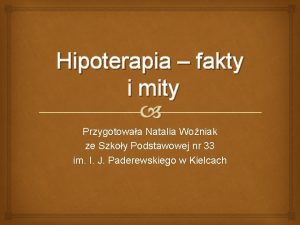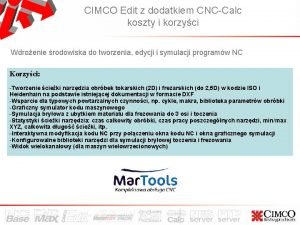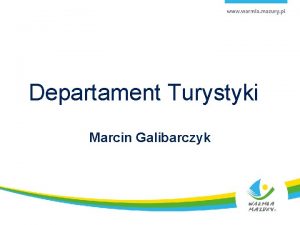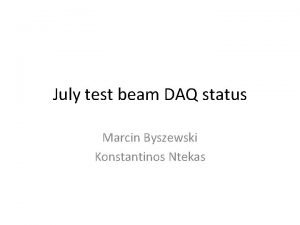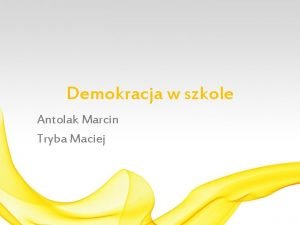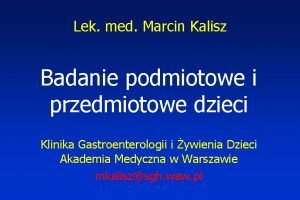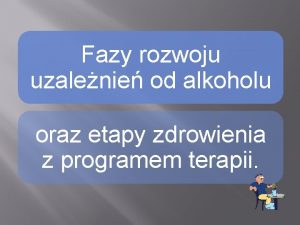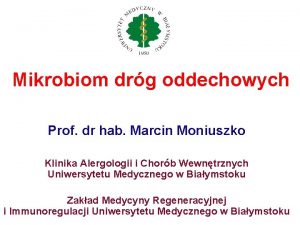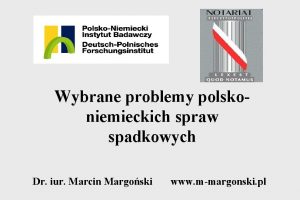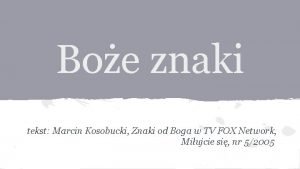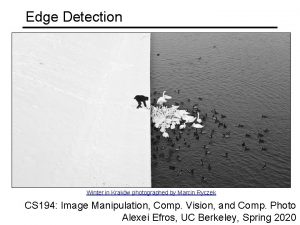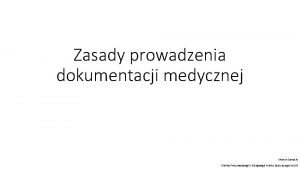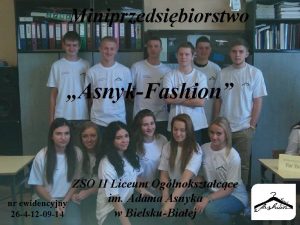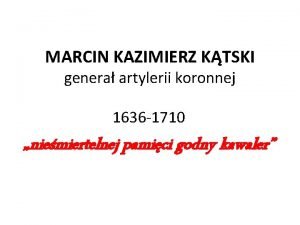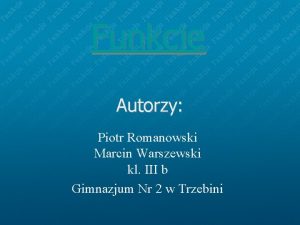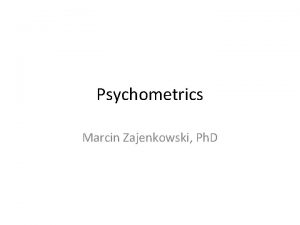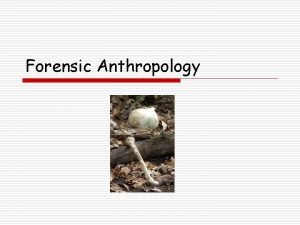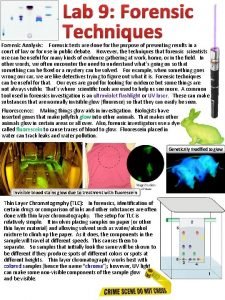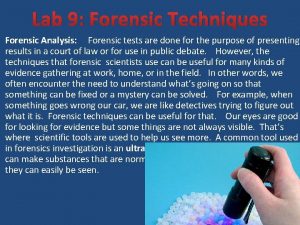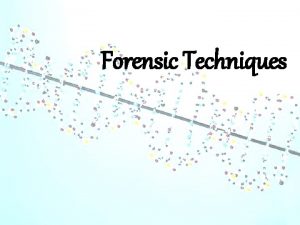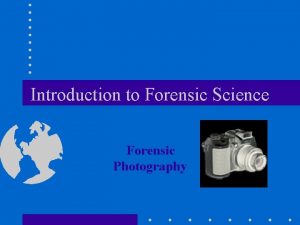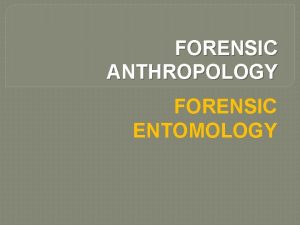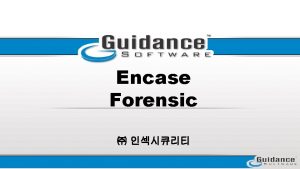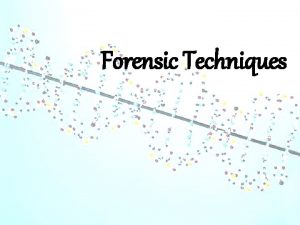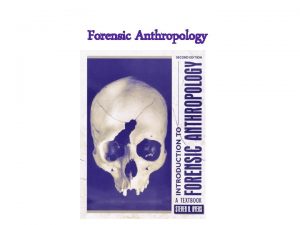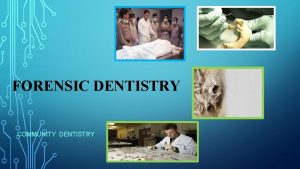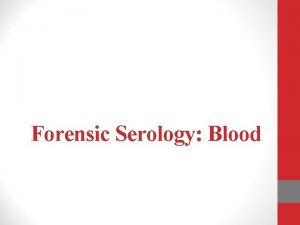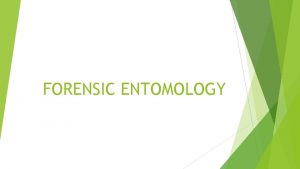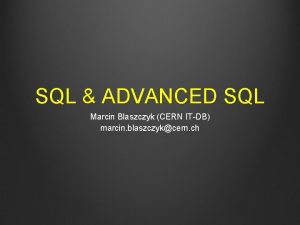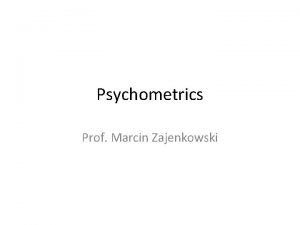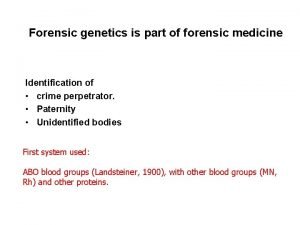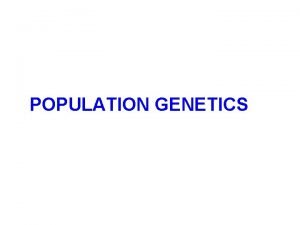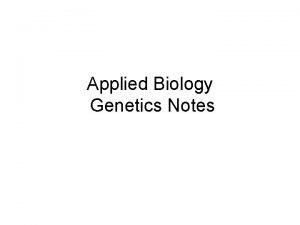Forensic genetics Marcin Woniak Ph D The Institute













































- Slides: 45

Forensic genetics Marcin Woźniak, Ph. D The Institute of Forensic Medicine Collegium Medicum UMK, Bydgoszcz

Biological substances individual and species identification

Missing persons identifications (human remains)

Kinship testing (paternity testing)

Genetic information In a cell: 3 x 109 b. p. x 2 = 2 meters of DNA ~2. 5 % genes . . . . .

Single nucleotide polymorphism (SNP) A T MUTATION G C

Tandem repeats AGCT 2 – 6 bp – microsatellites (STR) >10 bp – minisatellites Replication error AGCT + 1 repeat (or more) OR - 1 repeat (or more) AGCT

SNPs vs. tandem repeats SNPs Tandem repeats Sequence polymorphism Length polymorphism (detection: DNA sequencing) (detection: electrophoresis) 4 variants max (A, C, T or G) Many variants Millions in a genome Thousands in a genome Stable Unstable (mutation rate 1 in 10 -3) (mutation rate 1 in 10 -9)

Case No. 1: Narborough and Enderby murders • In 1983 a 15 y. o. Lynda Mann was raped and killed. In 1986 the same happened to 15 y. o. Dawn Ashworth • Richard Buckland admitted that he killed the second girl but denied any link to the first murder • FSS asked dr A. Jeffreys to resolve the case with his newly developed minisatellite profiling technique • The suspect was exluded (!!) • 5000 males were tested for ABO, c. a. 300 for DNA, alle were excluded • The perpetrator was found in a bar, boasting about how he escaped the tests. He was a local bakery employee, Collin Pitchfork.

The Innocence Project • The Innocenc Project was established in 1992 in Yeshiva University, Law Department • Founders: Barry C. Scheck and Peter J. Neufeld • Aim: offer help to innocent prisoners, whose innocence could be proven using DNA tests. • Results: (1989 - April 2017): 349 people exonerated in the USA, including 17 sentenced to capital punishment. 70% were sentenced after the year 2000(!) • Average time spend in prison: 14 years • Ethnicity (2012): 180 Afroamericans 82 Whites (Caucasians) 21 Latino 2 Asians 4 no information • In 149 cases the real perpetrators were identified

The Innocence Project

Technology leap 1985 - 2005 • Introduction of PCR – sensitivity from 1 g DNA to 0. 1 ng DNA (x 10000 up) • Minisatelites abandoned for microsatellites • Multiplex analysis • Fluorescent detection • New techniques: Y-STR i mt. DNA

Detection of biological traces • Blood and semen – preliminary and confirmatory tests • Saliva – preliminary tests (amylase) • Hairs – microscopic comparison • Epithelial cells, sweat - ALS • Fingernails • Excrements

Analysis of biological traces DNA extraction swabs stains on clothes cigarette butts hairs other amplification and genetic analysis

Simple multiplexes for STR amplification Gene. Print STR Multiplex CSF 1 PO, TPOX, TH 01 CTT PD=0. 99 F 13 A 01, FESFPS v. WA FFv D 13, D 7, D 16 Silver STR III PD=0. 999 CTT+FFv+Silver STR III PD = 0. 999 999 Denaturing PAA electrophoresis and silver staining

Fluorescent detection– multicolor tagging 300 150 200 250 7 9. 3 200 150 100 Computer analysis 8 20 15 18

Fluorescent detection of STRs Capillary electrophoresis ABI 3100 Slab gel electrophoresis ABI 377 19 STR loci

Genetic profile

Sex typing (amelogenin) AMEL FEMALE PCR amplification X X X AMEL MALE PCR amplification X X Y Y

Forensic genetics evolution Y-STR mt. DNA minisatellites microsatelites (STR) Serology 1985 1995 2005 phenotype 1983 PCR biogeographic origin individual ident. of animals and plants identification of tissues timeframe of stain deposition

Phenotyping • Amelogenin – sex • ABCC 11 – ear wax color and structure • HIris. Plex – 23 SNP mutations in 10 genes (MC 1 R, SLC 45 A 2, KITLG, EXOC 2, IRF 4, TYR, OCA 2, SLC 24 A 4, HERC 2, ASIP/PIGU)

Phenotyping

DNAwitness vs. witnesses • 2002 – a serial killer murdered 5 women in Luisiana • His STR profile was known but not present in CODIS • Witnesses claimed that the perpetrator was Caucasian • After many failed attempts an analysis of 171 AIMs (DNAWItness) was performed

Biogeographic origin 253272 SNP 2457 samples 23 populations

The future of forensic genetics • Tissue identification in ofrensic stains (micro. RNA? DNA methylation? ) • Skin color prediction (>10 SNPs? ) • Body height and body shape prediction (>200 SNPs? ) • Personal age prediction (sj. TRECs? DNA methylation? ) • Time of stain deposition (RNA degradation? melatonin/cortisol levels? ) • Personality prediction (abusive/agressive behaviour, stress coping etc. ) • Facial traits prediction (>5 SNPs? ) • Ethical and juridical issues (!)

marcinw@cm. umk. pl THANKS FOR LISTENING

Non-autosomal DNA markers Y Chromosome Mitochondrial DNA

Mitochondrial DNA (mt. DNA) • HV 1: 15998 -16417 • HV 2: 20 -425 • MVR 1: 16450 -16 • MVR 2: 403 -569 • Region V: 8196 -8316 • Cyt b: 14841 -15149 • 12 S r. RNA: 1091 -1478

mt. DNA as an identification tool • circular structure • many thousands of copies • maternally inherited • homogenous in different tissues • polimorphic

mt. DNA inheritance

mt. DNA in military service: Identification of missing soldiers Victims of mass executions Delta Force soldiers

Identification of a corpse based on mt. D analysis Hair shaft

Y-STRs in the analysis of biological stains STR analysis Differential DNA extr. Male profile STR analysis Semen DNA Epithelal cells DNA Swab from a rape victim STR DNA extraction ysis l ana Female profile Y-STR analysis DNA mixture Paternal line profile

Identification of forensic stains EXCERCISE 1

Interpretation of the results

Genotype frequency In diploid organisms DNA variants oocur as homozygotes or heterozygotes A A homozygote A B heterozygote B B homozygote

Hardy – Weinberg equilibrium and genotype frequency • If the population is infinite, stable in size, and panmictic then: • Heterozygote fequency: PAB = 2 p. Ap. B • Homozygote frequency: PA = p A 2 • In natural populations inbreeding coefficient (theta) should be applied

STR allele frequency database allel 8 9 10 11 12 SUM TPOX count frequency 541 0, 541 102 0, 102 61 0, 061 262 0, 262 34 0, 034 1000 1, 000

Genotype frequency Locus CSF 1 PO TH 01 TPOX allel Allele frequency 10 0, 268 11 0, 288 6 0, 226 9. 3 0, 312 8 0, 541 11 0, 262 Genotype frequency 0, 154 0, 141 0, 283 Profile frequency MP = 0, 006 i. e. 1 in 166 people

Statistical data interpretation • Analysis result: stain profile matches the suspect’s profile • Prosecutor hipothesis: if the two profiles are identical, they must come from the same person • Defence hypothesis: No way! The suspect was not present in the crime scene and the stain was left by somebody that has (by accident) the same profile • One can calculate which of the two hypotheses is more probable by calculating likelihood ratio (LR).

What is the chance that the stain will match the suspect if he was the donor? LR = 1 0, 006 = 166 What is the chance that the stain will match the suspect if he was not the donor? Prosecutor’s hypothesis is 166 times more probable than defence hypothesis LUB The profile is present in 1 person in 166 (!!!) DNA analysis gives 100% identification? ?

Kinship analysis EXERCISE 2

Paternity testing - basic ideas • Standard trio: mother-child-putative father • Child must share at least one allele with each parent at each locus • Mutations!! • Testing without mother?

Paternity confirmation Locus Alleged Father Child Mother PI CSF 1 PO 12 12 10 12 1, 710571 D 10 S 1248 13 14 13 13 13 14 2, 392344 D 12 S 391 15 23 18 19 4, 098361 D 13 S 317 8 11 11 13 1, 301067 D 1 S 1656 12 12 4, 166667 D 22 S 1045 15 15 11 15 2, 702703 D 2 S 441 14 15 10 14 10 12 1, 681237 D 5 S 818 12 13 12 12 3, 117207 D 7 S 820 8 13 8 11 10 11 2, 965599 ACTBP 2 21 31. 2 21 30. 2 25. 2 30. 2 13, 888889

Paternity exclusion Locus CSF 1 PO D 10 S 1248 D 12 S 391 D 13 S 317 D 1 S 1656 D 22 S 1045 D 2 S 441 D 5 S 818 D 7 S 820 ACTBP 2 TPOX D 16 S 539 D 18 S 51 D 19 S 433 D 21 S 11 D 2 S 1338 D 3 S 1358 D 8 S 1179 FGA TH 01 v. WA Child 13 15 21 12 11 11 11 20 8 11 16 14 27 15 16 11 21 6 17 13 15 22 12 14 14 11. 3 13 11 21. 2 11 12 18 15 30. 2 19 17 13 22 9. 3 18 Alleged Father 10 12 14 15 18 23 9 12 15 17 12 16 10 12 9 13 9 10 29. 2 30. 2 8 11 11 11 12 16 13 15 31. 2 32 23 25 14 15 10 14 20 24 6 9. 3 16 20
 Bajest
Bajest Woniak
Woniak Thomas mocker and thomas stewart
Thomas mocker and thomas stewart Who is this
Who is this Cimco nc base
Cimco nc base Marcin galibarczyk
Marcin galibarczyk Wotshack
Wotshack Maciej grabek
Maciej grabek Marcin brykczyński wikipedia
Marcin brykczyński wikipedia Marcin kalisz
Marcin kalisz Marcin sławek
Marcin sławek Marcin spyra
Marcin spyra Prof. dr hab. marcin moniuszko
Prof. dr hab. marcin moniuszko Marcin grzybek
Marcin grzybek Marcin margoński
Marcin margoński Znaki od boga
Znaki od boga Marcin kulinicz
Marcin kulinicz Marcin ryczek
Marcin ryczek Marcin kozak gwałt
Marcin kozak gwałt Marcin zydorowicz
Marcin zydorowicz Historia zdrowia i choroby wzór
Historia zdrowia i choroby wzór Sylwia grzeszczak data i miejsce urodzenia
Sylwia grzeszczak data i miejsce urodzenia Marcin stańczyk
Marcin stańczyk Marcin kątski
Marcin kątski Dr marcin majewski
Dr marcin majewski Nxcals
Nxcals Marcin warszewski
Marcin warszewski Turystyczny rachunek powierniczy
Turystyczny rachunek powierniczy Marcin zajenkowski
Marcin zajenkowski Thank you for your attention
Thank you for your attention Thế nào là hệ số cao nhất
Thế nào là hệ số cao nhất Sơ đồ cơ thể người
Sơ đồ cơ thể người Tư thế ngồi viết
Tư thế ngồi viết Bảng số nguyên tố lớn hơn 1000
Bảng số nguyên tố lớn hơn 1000 đặc điểm cơ thể của người tối cổ
đặc điểm cơ thể của người tối cổ Mật thư tọa độ 5x5
Mật thư tọa độ 5x5 Các châu lục và đại dương trên thế giới
Các châu lục và đại dương trên thế giới Thang điểm glasgow
Thang điểm glasgow ưu thế lai là gì
ưu thế lai là gì Thẻ vin
Thẻ vin Cái miệng nó xinh thế chỉ nói điều hay thôi
Cái miệng nó xinh thế chỉ nói điều hay thôi Các châu lục và đại dương trên thế giới
Các châu lục và đại dương trên thế giới Bổ thể
Bổ thể Từ ngữ thể hiện lòng nhân hậu
Từ ngữ thể hiện lòng nhân hậu Tư thế ngồi viết
Tư thế ngồi viết

